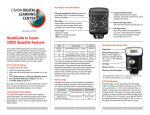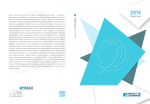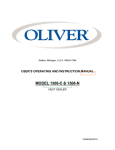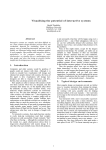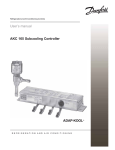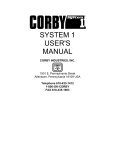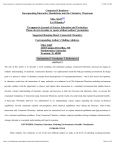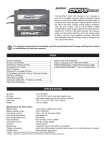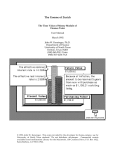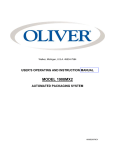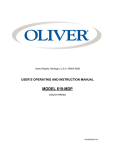Download Watt do you know about the cost of watts?
Transcript
Watt Do You Know about The Cost of Watts? A Study in the Cost of Electricity For Grades 5 to 12 Watt Do You Know about The Cost of Watts? Unit Overview ............................................................... 1 Steps in Determing the Cost of Electricity .............................. 2 Conclusion ................................................................... 6 Cost of Electricity Quiz (Attachment A) ................................. 7 A Teacher's Approach to Using This Unit ............................... 12 I. Time and Sequence ....................................... 13 II. Overview and Outcomes ................................ 13 III. Unit Activity Plan ........................................ 14 IV. Day-to-Day Plans ......................................... 21 V. Evaluation Forms ......................................... 25 VI. Self-Reflection for Journal ............................. 28 ©2002 PPL Corporation COST OF ELECTRICITY Watt Do You Know about The Cost of Watts? What Does It Cost? Why Teach It? Most people know what electricity is, but many people have misconceptions about what electricity actually costs when it is used in the home or elsewhere. We often hear about electricity (especially electric heat) being expensive. This lesson will allow students to determine how much electricity is being used and then calculate the cost. 1. Start off the lesson by asking students to complete a short, four-question quiz (see Attachment A) about how much it costs to operate an electrical device for the following tasks: Background: • Follow these steps to calculate the cost of electricity used for a specific task: 1. Determine the amount of electricity in watts (power) consumed by the electrical device when it operates. 2. Determine how long the electrical device operates for a given task. 3. Calculate the kilowatthours (KWH) of electricity consumed. 4. Multiply the KWH used by the cost per KWH to get the overall cost. ©2002 PPL Corporation COST OF ELECTRICITY Suggested Approach: • • • Preparing one slice of toast. Using an interactive video game for one hour. Preparing a meal using a crock pot. Heating one room of a house. The answers before and after the lesson may be surprising! Materials: • • • • • • Calculators Toaster Two slices of bread Pencils Copies of Attachment A Extra paper 1 Steps in Determining the Cost of Electricity: 1. The first step is understanding how electricity consumption is measured. Electrical consumption is generally stated in “kilowatt-hours” (KWH). One KWH is equal to 1,000 watts used for one hour. Electrical devices are usually marked with the power consumption in watts. A toaster, for example, may use 900 watts when operating. Slice of Toast (see question number 1 from Attachment A) For this example, assume it takes 106 seconds to make the toast. 900 watts • 106 secs 1 hour 1 KW • • 2 slices 3,600 secs 1,000 watts = 0.01325 KWH / 1 slice of toast 2. As part of the exercise, students will be asked to examine an electrical appliance to determine its power consumption. A toaster should be in the classroom (BE SURE IT IS NOT PLUGGED IN YET), and the students should examine the toaster to find the nameplate that lists the power consumption in watts. 3. After step 2 is completed, plug the toaster in and insert two slices of bread. Start the toaster and use a watch to determine how long (in seconds) it takes to make the toast. Now that you know the elapsed time and the wattage, you can calculate the energy consumed in KWH as follows: 2 4. The cost of electricity can either be determined by looking at a real electric bill or using a typical figure of $0.085/KWH. Using this figure along with the KWH determined in step 3, we get: 0.01325 KWH $0.085 • = $0.00113 / 1 slice KWH slice of toast. Another way to look at it is you can make eight slices of toast for less than one cent! This is calculated by the equation: $0.01 • 1 slice = 8.85 slices of toast $0.00113 5. Compare the actual cost of making a slice of toast to the students’ answers from the quiz. You might be surprised at the results! © 2002 PPL Corporation COST OF ELECTRICITY Additional Exercises: A. Playing a Video Game (see question number 2 from Attachment A) Once the basic concept of calculating the cost of electricity is learned, have students compute the cost for a task that has multiple uses of electricity. A good example is an interactive video game. There are three items to consider when using a video game: 1. The electricity used by the video game. 2. The electricity used by the TV. 3. The electricity used by a room light. Using the calculation method from step 3 in the earlier exercise, we get: 399 watts • 1 hour • 1 KW = 0.339 KWH for 1,000 watts one hour of play At $0.085/KWH, we get: 0.339 KWH • $0.085 KWH = $0.029 for one hour of video game play. All three items consume electricity and would be part of the calculation. Rather than have an actual video game and TV in the classroom, the following information can used for the consumption of each individual item: 1. Video game 2. TV (solid state) 3. Room light Total consumption: 79 watts 200 watts 60 watts 339 watts © 2002 PPL Corporation COST OF ELECTRICITY 3 Additional Exercises (continued): B. Using a Crock Pot (see question number 3 from Attachment A) For a crock pot which consumes 200 watts for 10 hours, the calculation is: 200 watts • 10 hours • 4 1 KW $0.085 • = $0.17 for the 10-hour cooking period. 1,000 watts KWH © 2002 PPL Corporation COST OF ELECTRICITY Additional Exercises (continued): C. Using an electric heater (see question number 4 from Attachment A) To heat one room of your house with an electric heater of 1,300 watts for eight hours, the calculation is: 1,300 watts • 8 hours • © 2002 PPL Corporation COST OF ELECTRICITY 1 KW $0.085 • = $0.88 for the eight-hour period. 1,000 watts KWH 5 Conclusions: Compare the results of the quiz to the calculated results. Some questions to ask the students: 6 • Were you surprised at the actual costs of the electricity ? • Would you like to calculate the cost of electricity for other uses ? (An aquarium with a heater, light and pump is one example. Another example would be a battery charger.) ©2002 PPL Corporation COST OF ELECTRICITY Attachment A Electricity — Is It a Bargain ? Please answer the following questions about the price of electricity. Do it by yourself, and don’t do a lot of calculations — just put down what you feel is the answer. Name _______________________________________________________________________ Grade ___________________ 1. What is the cost of electricity to make one slice of toast? 2. What is the cost of electricity when you play a video game for one hour? Keep in mind that the TV uses electricity and you may have a light on in the room while you are playing the game. 3. What is the cost of electricity if you use a crock pot for 10 hours to make a meal? 4. What is the cost of electricity to heat a room with an electric heater for eight hours? © 2002 PPL Corporation COST OF ELECTRICITY 7 Teacher‛s Notes 8 ©2002 PPL Corporation COST OF ELECTRICITY Teacher‛s Notes ©2002 PPL Corporation COST OF ELECTRICITY 9 Teacher‛s Notes 10 ©2002 PPL Corporation COST OF ELECTRICITY Watt Do You Know about The Cost of Watts? Program and User Manual for the Cost of Electricity: One Teacher‛s Approach Watt Do You Know about The Cost of Watts? Unit: Program and User Manual for The Cost of Electricity — One Teacher‛s Approach by Jason A. Henry, Parkland High School, Allentown, Pa. I.Time and Sequence This unit is to build a computer program to calculate the cost of electricity. This will be a two-week unit (or 10 days). Day 1: Developing math skills to calculate the cost of electricity. Day 2: Building a plan for the computer program. Days 3 & 4: Work on developing the computer program. Day 5: Instruction on building a user manual. Day 6: Finish up program and develop the user manual. Day 7: Peer evaluation day. Day 8: Redesign day if needed. Work in groups to better the programs. Day 9: Project presentation to class. Day 10: Project discussion day, journal entry day and due date. ©2002 PPL Corporation COST OF ELECTRICITY II. Overview and Outcomes I decided that I could create my classroom into a business world setting. I will first teach the students how to determine the amount of electricity in watts (power) consumed by the electrical device when it operates. Second, we will determine how long the electrical device operates for a given task. Then we can calculate the kilowatt-hours (KWH) of electricity consumed and multiply the KWH by the cost per KWH to get the overall cost. After the students understand the mathematical calculations involved in cost of electricity, I will have my computer program students develop a program about the cost of electricity. The program will be used to educate the community and employees about the cost of electricity. When they finish the program, they will have to create a user manual to show people how to use this program. They will have to do tests, then do revisions and finally create a product that any new employee or member of the community would be able to use by just sitting down with a manual and the program and figure out what to do. After we have a final product, we will go live on a fake intranet inside the classroom and discuss how communicating with the employees and community could benefit a company. This is basically the exact same thing I had to do at PPL. 13 III. Watt Do You Know about The Cost of Watts? What Does It Cost? Why Teach It? Suggested Approach: Most people know what electricity is, but many people have misconceptions about what electricity actually costs when it is used in the home or elsewhere. We often hear about electricity (especially electric heat) being expensive. This lesson will allow students to determine how much electricity is being used and then calculate the cost. 1. Start off the lesson by asking students to complete a short, four-question quiz (see attachment A) about how much it costs to operate an electrical device for the following tasks: Background: Follow these steps to calculate the cost of electricity used for a specific task: 1. Determine the amount of electricity in watts (power) consumed by the electrical device when it operates. 2. Determine how long the electrical device operates for a given task. 3. Calculate the kilowatthours (KWH) of electricity consumed. 4. Multiply the KWH used by the cost per KWH to get the overall cost. 5. Create a computer program to calculate these costs with given input. 6. Create a user manual to use the program. 7. Discuss what advantages are to community and employee education. 14 • • • • Preparing one slice of toast. Using an interactive video game for one hour. Preparing a meal using a crock pot. Heating one room of a house. The answers before and after the lesson may be surprising! Materials: • • • • • • Calculators Toaster Two slices of bread Pencils Copies of Attachment A Extra paper ©2002 PPL Corporation COST OF ELECTRICITY Steps in Determining the Cost of Electricity: 1. The first step is understanding how electricity consumption is measured. Electrical consumption is generally stated in “kilowatt-hours” (KWH). One KWH is equal to 1,000 watts used for one hour. Electrical devices are usually marked with the power consumption in watts. A toaster, for example, may use 900 watts when operating. Slice of Toast (see question number 1 from Attachment A) For this example, assume it takes 106 seconds to make the toast. 900 watts • 106 secs 1 hour 1 KW • • 2 slices 3,600 secs 1,000 watts = 0.01325 KWH / 1 slice of toast 2. As part of the exercise, students will be asked to examine an electrical appliance to determine its power consumption. A toaster should be in the classroom (BE SURE IT IS NOT PLUGGED IN YET), and the students should examine the toaster to find the nameplate that lists the power consumption in watts. 3. After step 2 is completed, plug the toaster in and insert two slices of bread. Start the toaster and use a watch to determine how long (in seconds) it takes to make the toast. Now that you know the elapsed time and the wattage, you can calculate the energy consumed in KWH as follows: © 2002 PPL Corporation COST OF ELECTRICITY 4. The cost of electricity can either be determined by looking at a real electric bill or using a typical figure of $0.085/KWH. Using this figure along with the KWH determined in step 3, we get: 0.01325 KWH $0.085 • = $0.00113 / 1 slice KWH slice of toast. Another way to look at it is you can make eight slices of toast for less than one cent! This is calculated by the equation: $0.01 • 1 slice = 8.85 slices of toast $0.00113 5. Compare the actual cost of making a slice of toast to the students’ answers from the quiz. You might be surprised at the results! 15 Additional Exercises: A. Playing a Video Game (see question number 2 from Attachment A) Once the basic concept of calculating the cost of electricity is learned, have students compute the cost for a task that has multiple uses of electricity. A good example is an interactive video game. There are three items to consider when using a video game: 1. The electricity used by the video game. 2. The electricity used by the TV. 3. The electricity used by a room light. Using the calculation method from step 3 in the earlier exercise, we get: 399 watts • 1 hour • 1 KW = 0.339 KWH for 1,000 watts one hour of play At $0.085/KWH, we get: 0.339 KWH • $0.085 KWH = $0.029 for one hour of video game play. All three items consume electricity and would be part of the calculation. Rather than have an actual video game and TV in the classroom, the following information can used for the consumption of each individual item: 1. Video game 2. TV (solid state) 3. Room light Total consumption: 16 79 watts 200 watts 60 watts 339 watts © 2002 PPL Corporation COST OF ELECTRICITY Additional Exercises (continued): B. Using a Crock Pot (see question number 3 from Attachment A) For a crock pot which consumes 200 watts for 10 hours, the calculation is: 200 watts • 10 hours • © 2002 PPL Corporation COST OF ELECTRICITY 1 KW $0.085 • = $0.17 for the 10-hour cooking period. 1,000 watts KWH 17 Additional Exercises (continued): C. Using an electric heater (see question number 4 from Attachment A) To heat one room of your house with an electric heater of 1,300 watts for eight hours, the calculation is: 1,300 watts • 8 hours • 18 1 KW $0.085 • = $0.88 for the eight-hour period. 1,000 watts KWH © 2002 PPL Corporation COST OF ELECTRICITY Conclusions: Compare the results of the quiz to the calculated results. Some questions to ask the students: ©2002 PPL Corporation COST OF ELECTRICITY • Were you surprised at the actual costs of the electricity ? • Would you like to calculate the cost of electricity for other uses ? (An aquarium with a heater, light and pump is one example. Another example would be a battery charger.) 19 Attachment A Electricity — Is It a Bargain ? Please answer the following questions about the price of electricity. Do it by yourself, and don’t do a lot of calculations — just put down what you feel is the answer. Name _______________________________________________________________________ Grade ___________________ 1. What is the cost of electricity to make one slice of toast? 2. What is the cost of electricity when you play a video game for one hour? Keep in mind that the TV uses electricity and you may have a light on in the room while you are playing the game. 3. What is the cost of electricity if you use a crock pot for 10 hours to make a meal? 4. What is the cost of electricity to heat a room with an electric heater for eight hours? 20 © 2002 PPL Corporation COST OF ELECTRICITY IV. Day to Day Plans DAY 1: DAY 2 Use the unit activity plan to teach the skills needed to calculate the cost of electricity. Make sure every student understands the mathematical process and formulas. Have students develop a rough plan for their computer program. This should be taught after students learned input boxes, if-then loop, and message boxes. Agenda: 1. Opening activity: PreQuiz. See Attachment 1. 2. Teach the formula — Use the unit activity plans. 3. Have students work in groups to complete the four questions correctly from the pre-quiz. Assessment: Students must complete the four questions to the pre-quiz correctly with 100 percent accuracy. Work in groups until all four questions are done. Agenda: 1. Start with a review of the mathematical formula to calculate the cost of electricity. 2. Review ideas of programming plans (flow charts and if-then loops). 3. Teach the uses of input boxes and messages boxes. 4. Give students time to develop a plan and ask questions. Assessment: Students must have a plan developed with the following requirement: 1. 2 input boxes 2. 1 message box 3. 1 command button 4. 1 picture box 5. 1 if-then loop to generate messages Example Program ©2002 PPL Corporation COST OF ELECTRICITY 21 Day 3 and 4 Have students work on their computer programs. Agenda: 1. Start each day with a review of concepts needed (formula, computer program skills). 2. Give time for students to work on computers and ask questions. 3. Keep students focused by injecting ideas throughout the period. (Share ideas from other student work.) Assessment: Students should remain on task throughout the two days working on their programs. DAY 5 Students will have to create a user manual to demonstrate the program’s process to any users. Agenda: 1. Show a few programs from class 2. Teach the structure of developing a user manual: User Manual — Example I. Look on the piece of equipment for the number of watts. II. Enter the number you found here: Number of III. Enter the time used here: Time used Note: Must be in hours. IV. Click on the Calculate Cost button: V. View Total Cost in the picture window: V. Click on the Quit button to close program: 22 Note: After clicking the Quit button you will get a “Goodbye” message. ©2002 PPL Corporation COST OF ELECTRICITY DAY 6 DAY 8 Give students another work day to work on any part of their project. Have students work in groups to do revisions if needed. Stress that the students must also change their user manual if they change their program. 1. Start with a review of user manual ideas. 2. Give students time to work on any part of their project (programs or user manual). Remind students both must be done by the next day in order to move on. DAY 7 Students that do not have programs and user manuals done must complete the two parts before doing this activity. They will have to do this activity on their own. Agenda: 1. Review what the program is supposed to do. 2. Review what the manual is supposed to do. 3. Give overview of the peer evaluation form. (See evaluation form section.) 4. Students that are finished will have time to get three student peer evaluations. 5. Students will also have to get two adult evaluations. ©2002 PPL Corporation COST OF ELECTRICITY Assessment: • Students must get evaluation forms completed by three peers and two adults. (See teacher final evaluation form.) Agenda: 1. Review peer evaluations and the need for the evaluations. Not everyone sees the program like the way the programmer sees it. 2. Give time to revise and explain due dates and the agendas for the next two days. 3. Discuss the students’ project presentation and requirement. DAY 9 Students will present their projects to the class in a fiveminute presentation. 23 DAY 10 Student will discuss in the classroom discussion the reasons for the procedures to the project. STRESS: the corporate world and the need to work together to revise and perfect programs. Students will enter a selfreflection in their journal and finalize all project details. The project will be formally handed in the next day (DAY 11). TOTAL POINTS FOR THE PROJECT: (100 points) Agenda: 1. Class discussion about the procedure of this project, why the need for a user manual, and why the need for a costof-electricity program. 2. Students will take a few minutes to write in their journal and fill out selfreflection paper. (See evaluation forms.) 3. Explain exactly what the students will need to hand in the next day. PARTICIPATION: 5 points PROJECT EVALUATION: 70 points PRESENTATION: 20 points JOURNAL ENTRY: 5 points Completed project consists of: a. Project plan with mathematical formulas b. Program code and form printouts c. Five peer evaluation forms d. Self-reflection form e. Journal entry 24 ©2002 PPL Corporation COST OF ELECTRICITY V. Evaluation Forms Peer Evaluation Form DESCRIPTION 5 HELP POINTS 3 HELP POINTS 1 HELP POINT 0 HELP POINTS Did you know where to begin? Everything was explained clearly, form was organized, and all extra information was given. Directions were given, but I needed to do some trial-anderror work. No directions. But the form is organized in order to help user. No directions and no organization. Is the form easy to read? Very easy to read. One thing is a little hard to read, but everything else is easy to read. More than one thing is hard to read, but not everything. Can’t read anything. Manual matches program. Excellent user manual. Needs more explanation. Doesn’t have anything to do with the program. Not done. Calculations and output are correct. Correct. Not correct, but code has correct formulas. Sometimes correct, but not always. Not correct. Your opinion: Excellent. No revision needed. Great, but could use a few revisions. OK, but should revise 50% of the program. Must revise 75% or more of the program. Overall program TOTAL HELP POINTS /25 COMMENTS: © 2002 PPL Corporation COST OF ELECTRICITY 25 Teacher Final Evaluation Form DESCRIPTION 10 POINT 7 POINTS 4 POINTS 0 POINTS Clarity. Everything was explained clearly, form was organized, and all extra information was given. Directions were given, but I needed to do some trial-anderror work. No directions, but the form is organized in order to help user. No directions and no organization. Organized form. Very easy to read. One thing a little hard to read, but everything else is easy to read. More than one thing is hard to read, but not everything. Can’t read anything. Manual matches program. Excellent user manual. Needs more explanation. Doesn’t have anything to do with the program. Not done. Calculations and output are correct. Correct. Not correct, but code has correct formulas. Sometimes correct, but not always. Not correct. Teacher perspective: Excellent. No revision needed (ALL input boxes, loops, and messages boxes used). Great, but could use a few revisions (Missing one or two required fields). OK, but should revise 50% of the program (missing more than two required fields). Must revise 75% or more of the program. Peer evaluation forms. 4 or 5 completed 3 Completed 1 or 2 completed 0 Completed (At least one adult) (At least one adult) (At least one adult) Self-evaluation form. Completed. _ _ Overall program. TOTAL POINTS Not completed. /70 COMMENTS: 26 © 2002 PPL Corporation COST OF ELECTRICITY Presentation Evaluation DESCRIPTION 5 POINTS 3 POINTS 0 POINTS Organization and presentation. Explanations are clear and concise. Good. OK. Not satisfactory. Two or more visual aids. Two or more visuals. Only one visual. No visuals. Classmates were involved. Excellent use of classmate involvement. Some good use of classmate involvement. Not satisfactory or no use of classmate involvement. Good use of time. Between 5 and 10 minutes. Over or under time limit by 1 minute. Over or under time limit by more than 1 minute. TOTAL POINTS /20 COMMENTS: © 2002 PPL Corporation COST OF ELECTRICITY 27 Self-Reflection for Journal Student Name:________________________________________ Date:___________________ Description of program: Self-evaluation of program: What I tried to accomplish: What I did: What I learned: What I am proud of about this program: What I need to work on or would do differently next time: Teacher Comments: Teacher Name: __________________________________________ 28 Date:_______________ © 2002 PPL Corporation COST OF ELECTRICITY Acknowledgements About Bob Janci: Bob is a retired senior environmental professional in PPL’s Environmental Management Deptartment. He has a bachelor’s degree in mechanical engineering. Bob has extensive experience in design and operation of power plants and their interaction with the environment. About Jason Henry: He’s a 1997 graduate of Bloomsburg University with a B.S. in education/mathematics, and a 2002 graduate of Wilkes University with an M.S. in education/classroom technology. He is currently training to instruct CISCO networking and is assistant baseball coach at Parkland High. Connections to State Academic Standards Because of the strong relationships of electricity to our society, connections between this manual and academic standards are evident throughout. The activities in this guide can be applied to several standards including science, social studies, history and math. ©2002 PPL Corporation COST OF ELECTRICITY

































